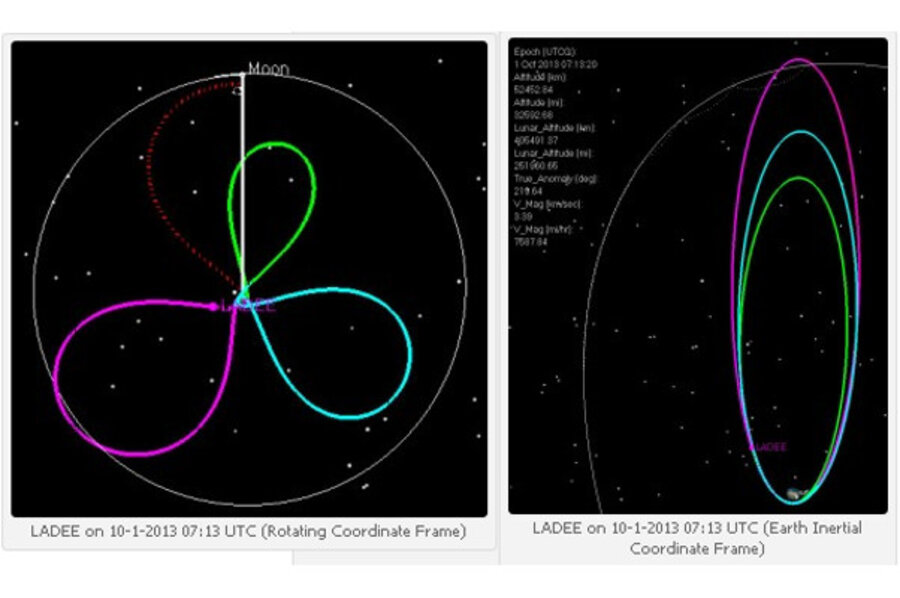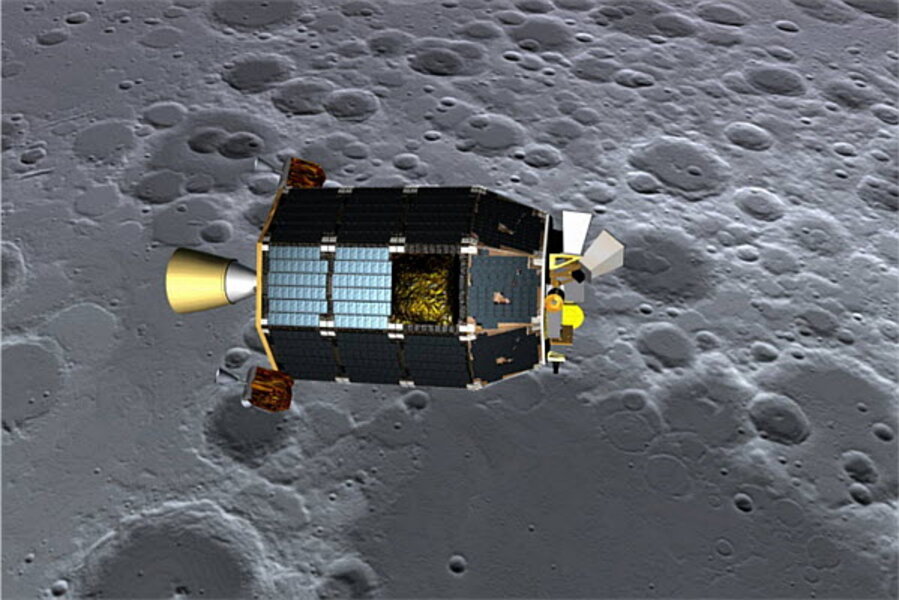Moon mission LADEE arrives after an 'amazingly precise' looping flight
More than 40 years after the last astronaut left the moon, NASA's next (robotic) explorer has arrived in lunar orbit. The Lunar Atmosphere and Dust Environment Explorer (LADEE) arrived right on schedule Sunday morning to investigate the twin mysteries of the moon's atmosphere and dust, after a picture-perfect launch and transit.
"The launch people really worked well and gave us just an absolutely perfect launch," says Mike Loucks, one of the "astrogators" (space navigators) planning LADEE's trip from the Earth to the moon. "It was just unbelievably precise… which made our job easy after that!" Though the team had prepared contingencies for any number of bobbles or snafus, none were needed.
Throughout the month-long flight, "the onboard propulsion system on the spacecraft has performed flawlessly as well, and been amazingly precise," says Loucks, who with the rest of the LADEE flight team was exempted from the NASA shutdown because their mission had already launched and needed their monitoring and maneuvering. "It's been remarkable."
It's tricky to define exactly when LADEE "got to the moon," since the robotic explorer didn't (and won't) land. Maybe when LADEE started orbiting? That happened with the first Lunar Orbit Insertion, or LOI-1, at 3:57 a.m. PDT on Sunday morning. But by then, LADEE had already been in the moon's "field of influence" — where the moon's gravity pulls more strongly than Earth's — for almost a day. Even before that, on October 2, LADEE crossed the midpoint of its final loop, and was closer to the moon than to Earth.
Loopy voyage
Imagine that the Earth-moon system is a clock, with Earth at the center and the moon at the tip of the second hand, smoothly sweeping around the Earth once a month. To get to the moon when it's at the 12 o'clock position, you need to leave Earth sometime sooner. During the Apollo missions, NASA took a straight shot to the moon, getting there as quickly as possible. In effect, they launched straight "up" the clock face, departing when the moon was at the 11 o'clock position.
LADEE didn't do that. The Apollo astronauts had a quicker flight — three days instead of 30 — but it required breathtaking precision and a mountain of fuel. Instead, LADEE flew along "phasing loops," taking big orbital swings around Earth until it crossed paths with the moon. Using the clock image, picture the little robot swinging out toward the 1 and back to the center, then down to the 4 and back to center, then over to the 8 and back to center, before finally arcing up to the 12 — arriving just as the moon sweeps by.
With this "phasing loop" approach, the astrogators built a nearly infinite amount of flexibility into their mission design. If the initial launch had been a bit low, or high, or fast, or slow, it wouldn't have mattered.
"We use those loops to open up our launch period," explains John Carrico, another flight dynamics expert and astrogator with the LADEE team. "If we had to launch a day late for some reason, we could still go to the moon exactly at the same time… by adjusting the orbit period, the time we spend in each loop."
Loucks compares phasing loops to using a slingshot to hit a moving target. You drop the rock in the slingshot, take a few twirls to get it under control, and then let it fly. The beauty of the phasing loops — those first few twirls — is that because they take about a week each, the astrogators have plenty of time to make any needed adjustments. In fact, in a worst-case scenario, LADEE could have stayed in its final looping orbit for another month, waiting for the moon to sweep past again.
"We kind of joked about it with the guys that built the rocket," Loucks says. "They were telling us, 'Well, what if we can't get into the exact orbit you want?' I go, 'Look, just get us in space. Just get us in orbit, and we'll get it to the moon.'"
The Apollo missions had almost no room for flexibility. Everything had to happen with perfect precision, and the astronauts burned a tremendous amount of fuel making the minute adjustments required to line everything up just so.
"The funny thing, of course, is that we got a precise launch, but we didn't anticipate that, and didn't need it in order to be successful," Loucks says.
It's like they set up an archery target, then piled a haymow behind it, and then hung a tarp behind that, all to guarantee they wouldn't lose their arrow — and then they shot a perfect bull's-eye.
By building in so much flexibility, the astrogators could nearly guarantee a successful flight to the moon, for a fraction of the cost of a less flexible approach. Loucks and Carrico are hoping that this phasing loop trajectory will be used by others seeking a relatively low-cost path to the moon. They're looking ahead to the commercialization of spaceflight, when repeatability, dependability, and cost-effectiveness will be the order of the day.
"A lot more people will go into space — for both academic and commercial reasons," says Carrico. "This really is letting humans become more spacefaring."
What's next for LADEE?
After completing LOI-1 on Sunday, LADEE takes three elliptical laps around the moon in as many days, then will perform its second orbit insertion maneuver (LOI-2) at 3:37 a.m. PDT Wednesday morning, October 9. That will slow LADEE's orbit down to one lap every four hours. The third maneuver, planned for late Saturday night, will round LADEE's orbit from an ellipse into a circle.
LADEE will spend a month in this circular "commissioning" orbit while its lasers begin communicating with Earth and the lunar science equipment goes through its final testing. After a month to settle into the neighborhood, LADEE will sink down to just a few miles above the lunar surface, where it will skim the "exosphere", orbiting 12 times a day, for the next three months. The $280 million mission will study the moon's almost nonexistent atmosphere and examine the mysterious lunar dust.
The moon's "exosphere," so thin that individual air molecules don't even touch each other, could be related to the odd "lunar glow" that Apollo astronauts spotted in the 1960s and 1970s. LADEE will scoop up particles from the atmosphere as well as dust migrating across the lunar surface. Understanding moon dust is key to future missions because it gums up spacesuit seals and can interfere with rovers and other equipment.







